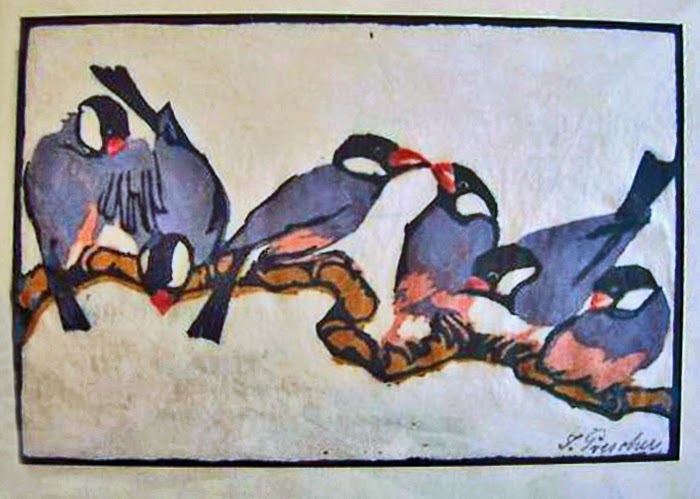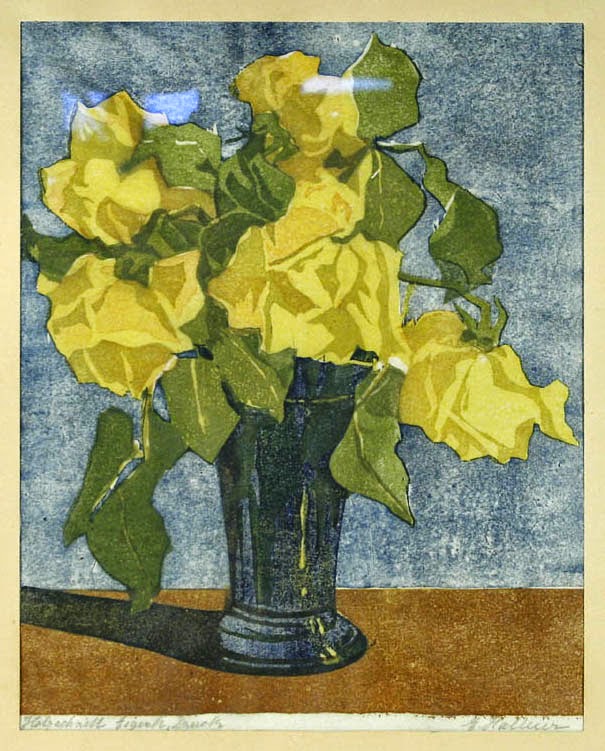Erna Halleur
Born 1860/85 - died Berlin 1940.
German painter and printmaker.
One of the loveliest printmakers in my "Early German Women
Printmakers Index" (and ongoing project) is Erna Halleur. She is also one of the most obscured (or is
it obscure ?)
This lovely bouquet, new to me, recently surfaced and was acquired by American reader Michelle who's send me a picture for sharing. A fine opportunity for this posting and to try solving the mysteries around Erna Halleur by asking the help of readers for information.
Erna's year of death is found in the archives of the Berlin Women Artists Association founded in 1865: “Künstlerin tätig in Berlin, gest. 1940 ebenda”, working in Berlin, a member for 27 years from 1913-1940 and
vice-secretary in 1916 and no records, no exhibitions, no traces in the Academy, not mentioned by friends or colleagues ?
She seems to have been exclusively busy with flower pieces (I like flower prints) and my guess, working in Berlin since 1916, she is in someway related/acquainted with Lovis Corinth (1858-1925). Like printmaker and colleague Else von Schmiedeberg-Blume (1876-) who confessed "being inspired" by Corinth's flower paintings. And of course with Emil Orlik (1870-1932). All three of them taught in Berlin for many years.
Although Erna is not mentioned in any of the Artist Lexicons to day she has a select group of international admirers and connoisseur considering the always high prices her prints fetch in auctions. From America to Taiwan, from Germany to Cornwall. My "Snow Drops" however is lovely, but it's the only color etching I know or have ever seen by her. Swapping it for one of her block prints, more befitting my personal aim of collecting, is an option.


It took me a while but I found Erna in a 1935 census living in the (Schöneberg area) Motz-strasse 63: “Erna Halleur, Mahlerin und
Grafikerin”, painter and graphic artist. There are only two other Halleurs living in Berlin in 1935: Ida Halleur a “Rentiere” (living from a pension) in the
Augsburgerstrasse 23 also in quarter Schöneberg and Jean Halleur in the Stubenrauchstrasse
44 which is in the adjacent Friedenau
quarter. He was a “Kanzler”, a position meaning either a high official in a consulate, or a
diocese or as a university secretary/director.
Reader and follower "Archimandrill" (see comments) additionally has send this nice example below from a British 2004 online auction catalogue.
Physalis and Meissen porcelain statue group (47 x 49 cm.
I have examples of half a dozen water colors, all flowers, by Erna but because this has become a rather lengthy posting I've left those out of this article)
---------------------------------------------
Motzstrasse - Nollendorfplatz
(Schöneberg-Berlin)
The Motz-strasse and nearby Nollendorfplatz and Bahnhof (Square and Metrostation) in the the 1920’s were
in a swinging, artistic and liberal quarter of Berlin, the home of writers,
painters, artists, jews and the place to be for homosexuals (male/female). Around two corners (a block) away was the drawing school of the Womens Artist Association.
 |
| Lesser Ury: Nollendorferplatz-Motzstrasse |
Leo Lesser Ury (1861-1931), the impressionist frequently painted the streets in this area of Berlin.
On the same address Motz-Street 63 in 1929 lived
the family of Dr. Julius Lewin renting rooms in 1929 to Jewish American journalist and writer Shepard
Stone (Cohen) (1908-1990) who came to study in Berlin. Read her* especially the Weimar Student part.
Just a few buildings away at Nr. 78 was
Hotel Koschel (now Hotel Sachsenhof) where painter Oscar Kokoschka (1886-1980) stayed and writer Else Lasker-Schüler (1869-1945) who has
a school named after her in the same street.
 |
| Pariser Platz, Oskar Kokoschka |
Across the street at nr. 82 lived Jewish (art) doll maker Else Hecht-Grossman (1884 - deported and murdered in Riga 1942). She was member of the Munich Art Doll Group. Erna and Else could easily have bumped in to each other or have met at the grocers. The German "Hecht", by the way translates Pike explaining the label.
 |
| Nollendorfplatz |
Max Beckman (1884-1950)
 |
| Schönheitsabend in der Motzstrasse 1918 |
George Grosz (1893-1959).
 |
| Nollendorfplatz |
Ernst Ludwig Kirchner (1880-1938)
Here are some more names of
important figures who walked the streets with Erna Halleur in this artistic quarter of Berlin:
Berthold Brecht, Vladimir Nabokov, Ernst Bloch, Rudolf Steiner, Alfred
Döblin.
And this is what was left in 1946: ruins and rubble.
Erna's world vanished from the planet.
---------------------------------------
Most German Halleur namesakes seem to
originate from the city of Schwerin in Province Mecklenburg-Vorpommern, some
100 km. east of Hamburg. The name also spelled as Halleer, Hallier etc..)
(Gustav Carl) Hermann Halleur, probably the most interesting member, was also born in Schwerin in 1818. In 1854
he published a very early and iconic text book on photography, describing how to create lasting
impressions using all sorts of material from nature (auto-photography, very interesting
stuff).
Researching him a bit on a rainy
day I found Hermann in an earlier life had also been a doctor and a missionary visiting West Africa and Jamaica
and writing a book about the life and treatment of negroes in West Africa concerning
slavery. He was chosen to travel with the explorer Alexander von Humboldt (1769-1859).
Halleur remarried his second wife (the daughter of
a British Major “Honntybon”) on the Ilse of St. Helena. I could find no family name anywhere near
“Honntybon”, but there was an Irish Major Poppleton (..) on St. Helena …….: garding
Napoleon Bonaparte in his exile (1815-1821). It also could well be "the Honn........ so and so", later German translators missing the point ?
G.C. Hermann Halleur was also involved in the founding of the University of Calcutta in India. Returned to Germany he left Berlin in 1851 and was awarded a
directorship with a grant from the German King to lead the newly founded Arts
and Craft school in Bochum near Essen. An artistic link or a clue to Erna or is it wishful thinking ?
All pictures borrowed freely from the internet for friendly, educational and non commercial use only.
All information on Erna Halleur is warmly welcomed !
































.jpg)

























